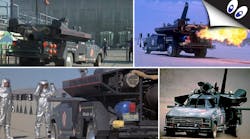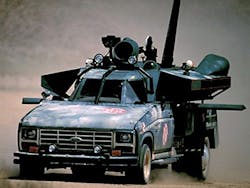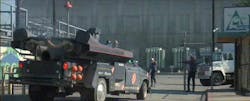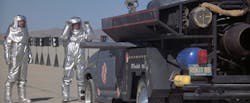Series: April 1, 2020: What's Trending in Technology?
Repeated sightings of an odd-looking Tesla Cybertruck at various truck stops in and around Fremont, Calif. appear to confirm long-standing rumors that the unthinkable has occurred: The planet's leading manufacturer of electric vehicles will be powering at least one of its models with an internal combustion engine (ICE).
While corporate spokespeople refused comment on the matter, several formal employees confirmed that an advanced ICE technology project had been underway for more than two years. The information they shared, and the Cybertruck's appearances at truck stops, confirmed suspicions that the Tesla power plant was some sort of high-performance diesel engine.
Electronic Design has obtained a series of PowerPoint slides leaked from Tesla headquarters that fill in a few other details about the counter-intuitive business strategy behind this unique vehicle. The idea of offering an ICE power plant was first conceived of as a stopgap measure about three years ago, when it wasn't clear whether Tesla's then-nascent Gigafactory would be able to manufacture enough batteries to meet the growing demand for its vehicles.
Although the ICE-powered truck was conceived as a way to maintain growing sales in the face of battery manufacturing shortfalls, it was also meant to serve as a "gateway drug" to bring hard-core gasoline users to the Tesla brand. Around that time, Tesla's marketing team had identified a market segment (roughly 40% of American drivers) who said that they would continue to purchase petroleum-powered vehicles until, as one focus group participant put it, "they pry the gas nozzle from my cold, dead fingers."
Most people who were surveyed attributed their aversion to EVs to an extreme form of range anxiety. Still, nearly 10% shunned electric cars and other so-called sustainable technologies because they believed them to be part of a large, shadowy conspiracy.
To help counter any lingering perceptions that Tesla makes "sissified" vehicles, the ICE power plant is derived from Audi's A15 TDI motor, a 5.5-liter turbocharged V10 racing diesel1 capable of producing over 600 horsepower. Since weight is less of an issue for the truck, its engine block and other components were strengthened to allow it to perform reliably under the day-to-day rigors of commuting, grocery runs, and hauling loads of gravel and manure. Even without its turbochargers (eliminated to keep costs down), the Tesla diesel is reported to produce nearly 400 horsepower, and that's before activating either of the vehicle's "alternate fuel modes." More about these shortly.
Eliminating the Cybertruck's 1200-lb. battery assembly lightens the vehicle considerably, and it creates an extremely large space for a fuel tank. Range anxiety will be a thing of the past with enough fuel aboard for 1,200-1,800 miles of driving, depending on the type of driving you're doing, and the type of fuel you’re using.
The Tesla diesel was designed to run cheerfully on the low-sulfur dino-juice available at any truck stop, but it delivers maximum performance when sipping RP-1, a highly refined type of kerosene, used to power many rockets, including Space-X's Falcon 9. The rocket fuel, which Tesla says will be available for sale at all Super Charger stations beginning Q3 of this year, burns much cleaner, allows the diesel to rev higher, and produce 20% more power.
For those who feel that 475hp is still insufficient, there's Sea Level Supercharging (SLSC). This $25,000 option allocates a portion of the battery bay's space to a vacuum-insulated cryogenic tank, which is used to store liquid oxygen (LOX) (also available at most Super Charger stations).
When SLSC mode is activated, the tank's precision heater system produces a controlled boil-off of pure oxygen, which is fed to the normally aspirated engine's intake. Sensors adjust the fuel injectors to deliver enough fuel to burn efficiently in the oxygen-enriched atmosphere, enabling the un-boosted engine to deliver the equivalent performance of a turbocharged power plant running at 2,000-2,200 bar.
The on-board LOX supply also enables Tesla to offer an exclusive "Overthruster Mode" for the ICE Cybertruck. For $450,000, Tesla will install one of its Kestrel rocket engines on the truck, along with propellant plumbing and a retractable protective engine shroud, and replace the driver and co-pilot's seats with a pair of acceleration couches. The Kestrel, a much smaller predecessor to the company's Falcon engine, also burns LOX/RP-1 and produces 6,900 pounds of thrust. It was retired from production nearly a decade ago, but several dozen of the engines were recently discovered in a storage facility.
This video, smuggled out from a NASA test facility on Groom Lake, Nev., documents the first successful run of the Overthruster at full power. Note: This demonstration was performed by a professional driver, on a closed course, using a highly-modified vehicle – do not attempt this at home. (Credit: MGM)
Tesla CEO Elon Musk is rumored to be reserving an Overthruster-equipped model for himself and making plans to have it modified it to support catapult launches off of a surplus aircraft carrier he’s trying to acquire (see "Insider Reveals New Disruptive Manufacturing Strategy, Denies Rumors of Orbiting Second Tesla Roadster" for details).
Information about the ICE truck's 0 to 60 performance for its normal or SLSC mode are unavailable at this time. Tesla has no plans to document the 0 to 60 time for the truck's Overthruster mode, but the company will include its 0 to Mach 1 performance in the owner's manual once NASA authorizes release of the test data.
Reference
1. Why Diesels Rule the Le Mans Raceway - https://www.popularmechanics.com/cars/a5865/le-mans-diesel-winners/




